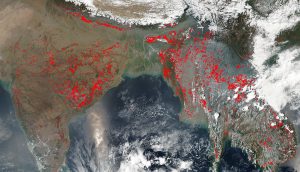Since China introduced its Environmental Protection Law in January 2015, environmental NGOs have spent almost two years testing it through a succession of public interest environmental lawsuits. This started in July 2015, when agents representing 13 provinces and authorised by the National People’s Congress, started bringing cases to trial.
So far, the courts have accepted 189 public interest environmental cases, of which 60% were brought by environmental NGOs.
It’s still early days for the law, and while the case outcomes are important the process is already playing a vital role in increasing public awareness of environmental protection and by providing precedents for others to follow in the future.
During this year’s annual NPC and CPPCC sessions (or Lianghui – two meetings), the Supreme People’s Court made information on a series of typical cases available to the public, a valuable step in providing references for other plaintiffs. Here are six of the most influential cases.
1. The threat of huge compensation: Taizhou pollution case
Companies were tried for dumping almost 25,000 tonnes of chemical waste into two rivers in 2012.
Verdict – The court found in favour of Taizhou Environmental Federation, the social organisation which brought the case, ordering six companies to pay a total of 160 million yuan (US$23 million) in compensation, as well as 100,000 yuan (US$14,500) in assessment costs.
Lesson – This case was a warning to polluting companies that they are liable to pay the cost of their pollution, and that fines can be expensive.
2. The desert is not a dump: Tengger Desert cases
The Tengger Desert stretches across three provinces in China’s north-west and although it looks desolate, its scattered lakes and groundwater systems support herders and livestock. Unfortunately, this didn’t stop eight chemical firms from using the desert as a dump for polluted waste water. In August 2015, the Green Development Foundation brought a case to the Ningxia First Intermediate People’s Court requesting that the companies halt the release of waste water and restore the environment. The court refused to hear the case on the grounds that the NGO was not “active in environmental public interest activities”, which they successfully appealed in the Supreme People’s Court.
Verdict – In its judgement the Supreme People’s Court said “active in environmental public interest activities” was not just limited to direct involvement in improving the environment but included other activities that benefit environmental governance such as public education, legal aid and bringing public interest lawsuits.
Lesson – The dumping case is still underway but regardless of the outcome it has reinforced the legitimate role of NGOs to bring cases.
3. Measuring damage: first Dezhou air pollution case
A glass-making factory in Dezhou, Shandong province was breaching environmental regulations with waste gas emissions that were a serious health concern to local residents. To force the company to stop, the All-China Environmental Federation, an NGO under the Ministry of Environmental Protection, sued the company.
Verdict –On July 20, 2016, the court of first hearing ordered the company to pay 20 million yuan (US$2.9 million) in compensation.
Lesson – There is currently no globally agreed method for calculating harm caused by atmospheric pollution. In this case the court approved the calculation used by the plaintiff, which will be helpful in the handling of future cases. However, the NGO was left to foot the bill. So a clear win for the environment but leaving room for improvement.
4. Groundwater without borders: Three Gorges water pollution case
When a firm in Hubei started illegal mining operations, waste water and tailings soon began flowing directly into the Qianzhangyan Reservoir, an important source of drinking water for two provinces. Environmental group Chongqing Green Volunteers Union took the mining company to court.
Verdict – The request was upheld and the mining firm was ordered to restore the environment and cease operations until an environmental impact assessment was carried out.
Lesson – Although the mine was in Hubei, most of the affected reservoir lies in Chongqing, where the case was heard. The case assigned responsibility for pollution across provincial borders.
5. Rural pollution is serious: Jiangsu pig farming case
A pig farm owned by a cooperative in Jiangyin, Jiangsu province opened without an assessment or any inspection by authorities. Soon enough, it was causing serious pollution that was affecting nearby villages. The All-China Environmental Federation requested a court order to stop the illegal farming.
Verdict – The court found in favour of the All-China Environmental Federation.
Lesson – The case highlighted the gravity of environmental pollution in China’s rural areas, which is worsening and taken less seriously than urban pollution.
6. The procurator suing another government: Liupanshui illegal dumping case
It’s not just polluters that can end up in court – government bodies that don’t fulfil their responsibilities can also be brought to book, even across administrative borders. In the first cross-border environmental public interest lawsuit in China, a township in Liupan, Guizhou province used a piece of land as a temporary dump for household waste. This caused pollution and forced the neighbouring administration to take the township to court
Verdict – The plaintiff won.
Lesson – Such cross-jurisdictional cases help combat local protectionism and encourage government bodies to fulfil their legal duties.





![Arctic ice continues to melt, we must approach the challenge with some hope [image by: NASA/Kathryn Hansen]](https://dialogue.earth/content/uploads/2017/04/Arctic-ice-NASA-300x200.jpg)


